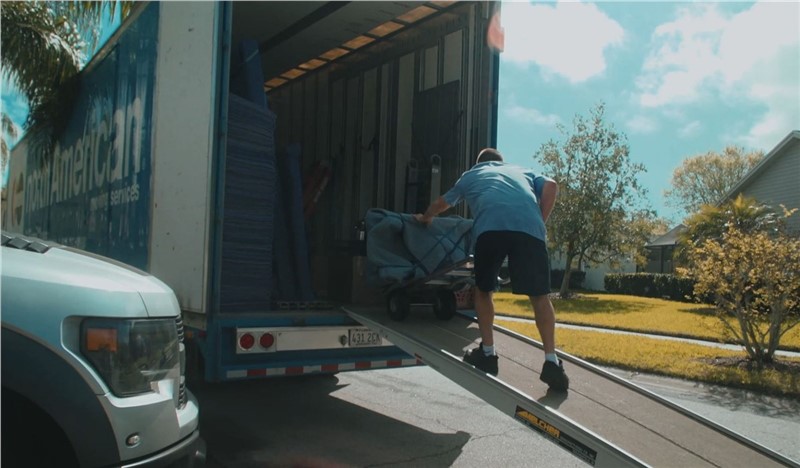How to avoid delays in international moving and how to prevent them
Comprehending the Inclusions of moving and Freight Forwarding worldwide of International and domestic Delivery
Steering through the complexities of moving and Freight forwarding can be challenging. Both procedures involve distinctive procedures and demands that are essential for successful transportation. Recognizing the distinctions in logistics, documentation, and danger administration is essential for individuals and companies alike. This expertise can significantly impact the effectiveness and security of shipments. Lots of are uninformed of the particular elements that influence the general experience and results. What factors should one think about to ensure a smooth changeover?
The Basics of moving and Freight Forwarding
moving and Freight forwarding are essential parts of the worldwide logistics market. They assist in the transfer of items and individual possessions across residential and worldwide borders. moving primarily involves the relocation of family members or people, incorporating residential and industrial demands. It typically consists of packing, packing, transferring, and unpacking things at the destination. On the other hand, Freight forwarding is concentrated on the delivery of products, typically wholesale, utilizing different transportation settings, such as land.freight, air, or sea forwarders work as middlemans, collaborating logistics to guarantee timely shipment while maneuvering through facility policies and customizeds procedures. Both procedures call for mindful preparation, company, and interaction to assure effectiveness and decrease disturbances. Understanding these fundamentals is vital for any person entailed in logistics, as they prepared for advanced elements of shipping and transport management.
Secret Parts of Freight Forwarding Services
Freight forwarding solutions include several critical components that guarantee smooth transport of products. Key responsibilities of Freight forwarders include taking care of logistics, collaborating deliveries, and managing personalizeds clearance. In addition, recognizing necessary shipping documentation is vital for compliance and reliable motion of cargo.
Freight Forwarder Responsibilities
A trusted Freight forwarder plays an essential duty in collaborating the transport of items, guaranteeing that shipments are managed successfully and in conformity with regulations. Their responsibilities include various essential tasks, including choosing optimal transport paths, discussing Freight rates, and managing logistics. They work as intermediaries in between carriers and carriers, making sure that cargo is correctly packaged and labeled for secure transportation. In addition, Freight forwarders track shipments, giving updates to clients regarding the status and expected distribution times. They also analyze and manage threats related to transportation, recommending insurance policy options as required. By helping with interaction and documentation, Freight forwarders enhance the delivery process, reducing prospective delays and boosting general supply chain effectiveness.
Delivering Documents Basics

Understanding Custom-mades Clearance and Documentation
Precise documentation is vital in the personalizeds clearance process, as it ensures conformity with different guidelines. An introduction of customs guidelines highlights the intricacies dealt with by shippers and Freight forwarders. Common clearance challenges can significantly affect delivery timelines and prices, making understanding this aspect crucial for efficient logistics.
Significance of Accurate Documents
Guiding through the complexities of worldwide delivery requires an eager understanding of customizeds clearance and the critical duty of paperwork. Precise documentation is crucial for making certain that deliveries conform with regulations and reach their locations without hold-ups. Appropriately prepared papers, consisting of costs of lading, commercial invoices, and packaging lists, help with smooth interactions with customizeds authorities. Inaccuracies can lead to shipment hold-ups, penalties, and even confiscation of products. Complete documentation aids in tracking shipments and fixing conflicts. Subsequently, businesses took part in moving and Freight forwarding should prioritize careful documents techniques to navigate the elaborate landscape of global delivery properly. This persistance not only simplifies operations yet likewise boosts client contentment by making sure timely shipment.
Customs Rules Summary
Guiding customs laws is a crucial element of worldwide trade that directly influences the success of moving and Freight forwarding operations. Efficient custom-mades clearance needs an understanding of various policies, including tariffs, duties, and import/export limitations. Precise documentation is essential, as it ensures conformity with lawful needs and helps with the effective movement of goods across borders. Secret records often include industrial billings, packaging lists, and expenses of lading, which give comprehensive info concerning the shipment. In addition, customizeds brokers play a critical duty in guiding complicated policies, acting as middlemans between carriers and customizeds authorities. By preserving detailed expertise of personalizeds procedures, services can substantially decrease hold-ups and minimize expenses linked with global delivery.
Typical Clearance Obstacles
Various difficulties can emerge throughout the customs clearance procedure, frequently complicating the activity of products throughout boundaries. One substantial concern is insufficient paperwork, which can lead to hold-ups and charges. Importers and merchants have to ensure all required documentation, such cheap movers from state to state as billings, packing checklists, and certifications of origin, is accurate and full. In addition, disparities in assessment can set off scrutiny from custom-mades authorities, resulting in added obligations or examinations. Language barriers might likewise position difficulties, as miscommunication can result in misunderstandings relating to laws. In addition, changes in custom-mades regulations can produce complication, necessitating continuous alertness by shippers. Inevitably, conquering these clearance tests calls for detailed preparation and a clear understanding of custom-mades requirements to help with smooth global purchases.
Packaging and Identifying Needs
Although commonly neglected, product packaging and labeling demands play an essential function in the delivery procedure, making sure that products are secured and easily identifiable throughout their journey. Proper packaging safeguards things from damages throughout transportation, while also assisting in efficient handling and storage. Making use of ideal products, such as bubble cover, foam, or durable boxes, can avoid breakage and loss.Labeling is just as essential. Clear and exact labels share critical information, including the location, managing instructions, and components. Labels have to comply with guidelines details to global and residential shipping, which may include hazardous products identification or personalizeds declarations.Moreover, standardized labeling practices simplify the monitoring process and boost overall logistics performance. By adhering to product packaging and labeling requirements, businesses lessen the risk of hold-ups, damages, or misdelivery. Ultimately, these methods add substantially to the success of moving and Freight forwarding operations, making sure a smooth shipping experience for all events involved
Tracking Deliveries: Importance and Techniques
Reliable product packaging and labeling set the foundation for successful delivery administration, however tracking deliveries is just as essential in the shipping process. Delivery monitoring provides real-time exposure, which assists customers and organizations keep track of the development of their goods. This transparency improves consumer fulfillment, because clients can remain informed regarding shipment timelines and any kind of prospective delays.Several approaches promote efficient tracking. Barcode scanning is a typical approach, using unique identifiers to keep an eye on bundles throughout their journey. Furthermore, GPS technology allows exact place monitoring, permitting timely updates and enhanced logistics administration. Several shipping companies currently supply electronic systems and mobile applications that find more information supply individuals with simple access to tracking information.The importance of shipment monitoring can not be overemphasized; it lessens the danger of shed or harmed items, boosts functional performance, and fosters count on in between recipients and shippers. For that reason, incorporating efficient tracking methods is essential for effective domestic and global shipping operations.
Insurance policy Options for Your Product

Safeguarding insurance coverage for goods en route is an essential factor to consider for individuals and services alike. Insurance choices differ based on the kind of shipment, worth of goods, and details dangers entailed. Common kinds include service provider liability, which covers loss or damages while en route, and full-value insurance, supplying considerable insurance coverage for the overall value of the goods.Shippers may likewise consider aquatic insurance policy for global deliveries, safeguarding against threats connected with sea transport. It is essential to examine the details needs of the shipment and assess the conditions of any type of policy.Furthermore, comprehending exemptions and restrictions is crucial to avoid possible gaps in insurance coverage. Carriers need to involve with insurance professionals to explore tailored remedies that fit their unique situations. Ultimately, purchasing the appropriate insurance can alleviate financial risks and give assurance during the delivery process.
Picking the Right moving and Freight Forwarding Service
When selecting a moving and Freight forwarding service, it is vital for organizations and people to very carefully evaluate their specific needs and priorities. Variables such as the quantity of items, location, and timeline play a significant role in this decision-making procedure. Looking into different carriers is suggested; contrasting their solutions, rates, and consumer evaluations can reveal valuable insights.Additionally, it is needed to take into consideration the experience and competence of the service provider in dealing with specific sorts of cargo, specifically for worldwide shipments that may involve customizeds clearance. Openness in pricing, including any covert charges, should additionally be scrutinized.Furthermore, evaluating the degree of consumer assistance used is crucial, as prompt communication can alleviate issues during transit (domestic shipping). Finally, verifying the availability of insurance policy options ensures that products are protected throughout the shipping procedure. By taking these steps, individuals and services can make educated selections that align with their logistics demands
Regularly Asked Inquiries
What Sorts Of Product Can Be Shipped Internationally?

How Do Shipping Expenses Differ Between Various Service Providers?
Delivering expenses differ considerably between carriers as a result of factors such as service rate, freight kind, range, and added services supplied. Each provider's prices version reflects these variables, affecting total delivery costs for clients.
Can I Ship Hazardous Products or Perishables?
Shipping hazardous materials and perishables undergoes strict laws. Service providers typically call for certain product packaging, labeling, and paperwork. Shippers have to assure conformity with global and local laws to prevent fines and assure secure transport.
What Should I Do if My Delivery Is Delayed?
When faced with a shipment delay, one must first get in touch with the provider for updates. Examine any notifications got, evaluate different services, and maintain all events informed regarding the situation to reduce interruptions.
Exist Weight Limits for Shipping Containers?
Weight restrictions for delivery containers differ depending upon elements like container dimension and delivery regulations. Commonly, standard containers have an optimum gross weight of around 30,000 to 32,000 kilograms to assure safe transport and handling. In contrast, Freight forwarding is focused on the delivery of items, usually in mass, making use of different transportation modes, such as land.freight, sea, or air forwarders act as intermediaries, coordinating logistics to ensure timely delivery while steering via facility policies and personalizeds procedures. Key responsibilities of Freight forwarders consist of managing logistics, coordinating shipments, and handling customs clearance. A trustworthy Freight forwarder plays a crucial role in collaborating the transport of goods, making certain that shipments are dealt with efficiently and in compliance with laws. Efficient this link product packaging and labeling established the structure for successful shipment monitoring, yet tracking deliveries is just as important in the shipping procedure. Several shipping companies now supply electronic systems and mobile applications that give individuals with simple access to tracking information.The significance of delivery monitoring can not be overemphasized; it decreases the threat of shed or harmed products, improves functional effectiveness, and cultivates trust fund between receivers and carriers.